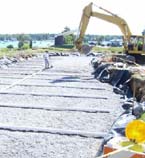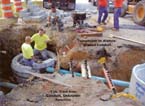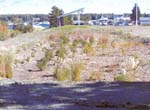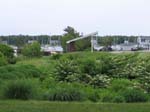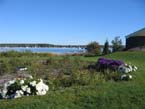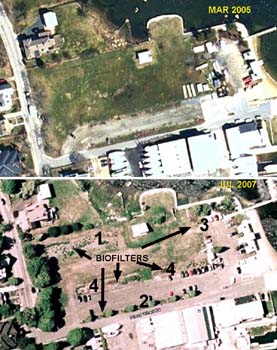Island Wharf Marina Stormwater Biofilters
Overview
Title: Island Wharf LID Stormwater Biofilter Project
Partners: The Marion Island Wharf stormwater project was implemented because of the work and leadership of Marion DPW Superintendent Rob Zora and his staff in overcoming a number of technical and financial obstacles. Supporting partners included the construction firm Lynch Botelho, and donated services from Eden Landscaping.
Total Cost: Grants Received: Bay Project National Estuary Program (Municipal Grant Program for stormwater designs, $20,000 completed by Horsley Witten Group), Sippican Historical and Preservation Society ($18,000), Massachusetts Coastal Zone Management (Coastal Pollution Remediation Grant $165,000), and town funding (cash and in-kind): $90,0000 estimated.
Status:This project was completed in 2006
[Some of the pictures and information presented here was taken in part from the grant application, and other information was taken from the Sippican Historical Society website.]
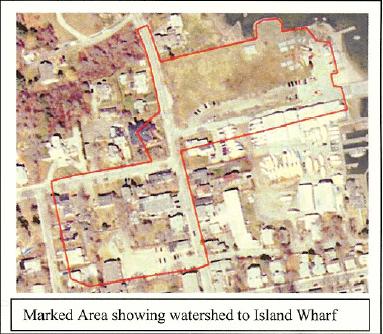
Project Description
The town of Marion proposed to construct bio-filters to treat two direct discharges of storm water into Sippican Harbor. Routine monitoring of water quality in Sippican Harbor by the Massachusetts Division of Marine Fisheries had shown elevated coliform discharges in the vicinity of three pipes near the town docks and Harbormaster offices. These elevated fecal coliform counts have resulted in a permanent closure of shellfish beds in that immediate vicinity. Due to the proximity of the shellfish beds and a public swimming area, the discharges have been rated “high priority” in the “Atlas of Stormwater Discharges the Buzzards Bay Watershed” produced by the Buzzards Bay Project National Estuary Program.
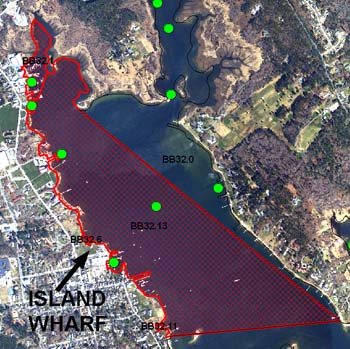
Shellfish beds beds closed near Island Wharf (BB32.1 and BB32.6
closed year-round, BB 32.13 closed during the summer.) Green circles are
DMF water testing sites.
The drainage area has been defined and the existing drainage system has been located though a previous CPR grant award. The existing stormdrain system was smoke tested to determine if any illicit connects existed. A preliminary design “Proposed Drainage Improvements” was prepared in 2000. Concern about the existing pollutant levels from pipes other than that treated by the water quality swale proposed in the 2000 design and concern about the sediment load generated from the municipal parking lot led the Town of Marion to consider a more comprehensive program than that designed in 2000. Work has been expanded, from the original idea to treat Front Street Drainage alone, to install 4 bio-filters and the necessary drainage and pretreatment facilities, to treat the first flush of pollutants from the Marion Village 5-acre watershed prior to discharge into Sippican Harbor. This entails these engineering and permitting elements.
- Replace the existing drainage system on Front Street to raise pipe elevations and replace catch basins.
- Install a pretreatment mechanism (Downstream Defender, a proprietary system has been selected due to issues relating to invert elevations.)
- Replacement of catch basin on Island Wharf Road with a deep sump catch basin
- Construction of 4 bio-filters (see plan “Island Wharf Biofilter Locations” and “Island Wharf Improvements”)
Click on the image thumbnail
Base of Biofilter #1.
Unanticipated issues during construction.
Completed Biofilter #1 in 2006, 1 growing season after project completion.
Biofilter #1 after 3 growing seasons (photo taken June 2009 by Dave Janik).
Biofilter #3 in 2007, 2 growing seasons after project completion.
Pollution Impacts Summary
Several species of shellfish are harvested from the waters of Sippican Harbor. Within the inner harbor, American oysters (Crassostrea virginica), quahogs (Mercenaria mercenaria) and soft-shell calms (Mya arenaria), are fished on both a commercial and recreational basis. The Town of Marion also operates and maintains a shellfish propagation area near the Harbormaster’s office. The town obtains seed from a certified dealer and maintains the cages until the shellfish are of a suitable age for transplant. The shellfish are then dispersed throughout Sippican Harbor.
The area of concern is one permanently closed area along the shore located just north of the Harbormaster’s Office. Located along the shoreline of the closed area, are three stormdrain pipes which discharge directly into Sippican Harbor. Monitoring data from DMF and the Marion Shellfish Department have indicated the pipes to be a serious pollution source (sites PS-30, PS-29 and PS-6A). Sippican Harbor is listed as a “FY 2005 Priority Area” by the Division of Marine Fisheries and is listed as a “Massachusetts Category 5 Water.”
The actual drainage area to these three pipes was defined in a previous CPRP funding cycle and was included in the “Atlas of Stormwater Discharges in the Buzzards Bay Watershed. (see attached map “Island Wharf Watershed, Marion Lower Village”) The various sources for stormwater in the Island Wharf Area are shown on the map “Island Wharf Impervious Surfaces, Marion Lower Village”” and summarized below:
| Drainage catchments | Impervious Area |
| Village | 2.5 acres |
| Island Wharf Road | 1.0 acres |
| Harbormaster’s Office | 0.4 acres |
| Field | 0.3 acres |
In addition to the DMF monitoring data, the Buzzards Bay Coalition, through their Citizens Water Quality Monitoring Program have been monitoring the waters of Sippican Harbor. This program was established in 1992 to document and evaluate nitrogen-related water quality and long-term ecological trends within Buzzards Bay. During the summer months, citizen volunteers collect data from monitoring stations within Buzzards Bay. This data results in a measurement of relative health (a “health index”) for all the major coves and harbors in Buzzards Bay. Based on the monitoring results, the health index for Sippican Inner Harbor has been ranked only as “fair.”
Natural resources and related human resources that are impaired
Currently, there are three stormwater pipes discharging within the closed shellfish area north of the Harbormaster’s Office. These pipes are adjacent to each other and drain approximately 7.5 acres of a multi-use watershed (residential, commercial and recreational). The most obvious impact of these pollutants is the resulting closure of the shellfish beds. In Sippican Harbor, four species of shellfish, American oysters (Crassostrea virginica), quahogs (Mercenaria mercenaria), bay scallop (Pecten irradians) and soft-shell clams (Mya arenaria) are commonly found. At the existing discharge site, the quahog and oyster fishery has been rated excellent by the Marion Shellfish Department (see the attached shellfish resource maps). All of these shellfish are harvested recreationally while only the quahogs and oysters are commercially harvested. In his 1995 Review to the Board of Selectmen, the Shellfish Officer estimated the value of the harvested shellfish from Sippican Harbor was over a quarter of a million dollars in the first ten months of the year. The Shellfish Officer stated that the depletion of finfish stock in coastal waters had increased the value of shellfish not only as a food source, but also as a recreational past time.
In the past, the Town of Marion had operated and maintained a shellfish propagation area near the current closure. American oysters and quahog seed would be purchased from a certified dealer, grown in cages and then transplanted throughout Sippican Harbor. The town, however, found the methodology to raise shellfish to be very labor-intensive. In 1998, the town received a research grant from Southeast Massachusetts Aquaculture Commission (SEMAC in Barnstable County) to explore labor-reducing options and to promote marine aquaculture as a viable industry. This aquaculture project was located in two areas within Sippican Harbor, one at the Harbormaster’s dock, the other at Tabor Academy (local private High School) dock. Both the students and faculty at Tabor will participate in this project by providing the necessary labor for building the facilities and by researching potential shellfish-growing alternatives.
For management purposes, the location of the propagation area at the Harbormaster’s Office is ideal. A major component for the success of this aquaculture project, however, is the ability to supply good quality water for shellfish propagation. Contaminants in the water can cause project setbacks by injuring or killing the seed stock. Although the water quality at the Harbormaster’s Office is considered good, any expansion of “polluted” water from the closed area, may impact the propagation effort.
In the Buzzards Bay NEP’s nitrogen study for Sippican Inner Harbor (A Buzzards Bay Embayment Subwatershed Evaluation: Establishing Priorities for Nitrogen Management Action, draft final May 3, 1994), the existing nitrogen loading is 16% over the limit for Outstanding Resource Waters (ORW) and is expected to be more than 69% over the limit in the future. The ORW designation for the harbor was selected for this study because of the potentially large eel grass habitat and shellfish habitat. Residential and commercial use account for approximately 79% of the existing inputs into the harbor. Most of the watershed draining to the harbor has been sewered including the areas with the highest residential (the village) and commercial (Route 6) density. The town continues to extend the sewer lines into this nitrogen-sensitive embayment, thereby reducing the nitrogen impact from failing septic systems.
During the summer months, the use of the public park adjacent to the Harbormaster’s Office and the associated waterfront increases dramatically. One of the four Marion public beaches is located here along with town-owned and operated moorings (see plan “Beach Location, both Public and Private”). The beach is the only public beach in Marion with unrestricted access for the general public. Due to the relatively calm harbor waters, families frequent the beach with small children. The close proximity of the discharge pipes, along with the associated shellfish closure, raises concern about the potential health hazard especially related to fecal coliform contamination. Beach-users have also reported algal blooms extending from the pipe outfalls to the beach.
Based on the existing information from the “Proposed Drainage Improvements, Town Park – Marion, MA” plan, a proposed site plan was drafted in 2005 to construct four bio-filters to treat runoff from the village commercial district and the Island Wharf area (see plan “Improvements to Island Wharf” dated May 17, 2004).
- Hydraulic failure, if any, would be visible.
- Needed maintenance was easily noted.
- The attractiveness of the bio-filter will have social acceptance.
- The high visibility of the bio-filters at the town park will act as an education and outreach tool.
Bioretention is a soil and plant-based stormwater management best management practice (BMP) employed to filter runoff from developed areas. Bioretention is a critical component of Low Impact Development (LID). LID is a philosophy of development in which steps are taken to maintain predevelopment hydrology, as near a possible. All green space is made functional to keep storm water onsite, to minimize runoff by maximizing infiltration, and to employ natural processes for water quality improvement.
Also known as a rain garden, a bioretention facility consists of a porous soil covered with a thin layer of mulch. A stand of various grasses, shrubs, and small trees is established to promote evapotranspiration, maintain soil porosity, encourage biological activity, and promote uptake of some pollutants. Runoff from an impervious area is directed into the bioretention facility. The water infiltrates through the plant/mulch/soil environment, providing the treatment. A typical bioretention cell with the various components labeled is shown above.
Bio-filter 1 will treat storm water from the village area and was sized for the first inch of runoff from the impervious surfaces. Bio-filter 2 will treat storm water from Island Wharf Road and 1/2 of the municipal parking lot and was sized for the first 1.25 inches of runoff from the impervious surfaces. Bio-filter 3 will treat storm water from the Harbormaster parking area and field and was sized for the first 1.25 inches of runoff from the impervious surfaces. Bio-filter 4 will treat storm water from field and 1/2 of the municipal parking area and was sized for the first 1.25 inches of runoff from the impervious surfaces. A bypass was constructed for larger flows contributing to Bio-filter 1. The bypass pipe for Bio-filter 1 was constructed of ADS 12″ pipe.
Stormwater in excess of the design flows for Bio-filters 2-4 will flow across the road to the existing drainage structure location. The catch basin in Island Wharf Road was replaced with a deep sump catch basin. The catch basin in the existing parking lot was eliminated and be replaced by an access manhole that provides access to the connection between the existing culvert and the Bio-filter 2 under-drain.
Because of the hydrology of the site, under-drains were installed in the bio-filters with a flap gate to prevent saltwater intrusion into the root zone of the bio-filters. To “daylight” the drainage system from Front Street, it was necessary to replace the existing drainage with new culverts at a higher elevation. In addition to the culvert replacement, a pre-treatment mechanism to capture winter road sand from Front Street was required. A proprietary system, “Downstream Defender” was selected as the pre-treatment mechanism because of the added benefit of a raised invert elevation on the outlet side. The existing road drainage system was removed and replaced with five new catch basins, and three new access manholes. The drainage pipe was a 12′ reinforce concrete pipe. The pipes were back-filled with flowable fill to prevent settling, and patched with asphalt. The joints of the patch were laser treated to prevent water intrusion and the resulting potholes. To reduce sediment load to the bio-filters, the municipal parking lot was paved and crowned to drain into Bio-filters 3 & 4.
To develop final designs from the 2000 plan and the new conceptual plan, “Island Wharf Improvements,” a consulting engineer was retained to perform final plans and detail of the new road drainage, The Buzzards Bay NEP provided planning and technical assistance to the town, and the town held a “neighborhood meeting” to discuss the project with the public.
A Notice of Intent was filed with the Marion Conservation Commission pursuant to the Massachusetts Wetlands Protection Act. Marion does not have a local wetlands bylaw. For projects regarding modifications to parking facilities, the Town of Marion Zoning Bylaws require a completed Plan and Site Review. The Plan and Site Review process calls for treatment of the first 1.25 inches of runoff from impervious surfaces. In the case of a retrofit situation, the standard may be relaxed if there is no alternative. A Plan and Site Review was filed with the Planning Board.
The Town of Marion DPW and the Sippican Historical & Preservation Society (SHPS) oversaw the work on-site. The SHPS has two volunteers that have experience in construction project supervision and one with experience in project management (Statement of Qualifications)
To construct the bio-filters the town, with assistance from Coastal Zone Management (CZM) and the Buzzards Bay Project, the town accomplished the following: hired a consulting engineering firm, held a neighborhood meeting, obtained permits from the Conservation Commission & Planning Board, constructed the bio-filters, installed a pre-treatment mechanism and flap gates, paved the municipal parking area, and replaced the drainage system in Front Street.
Operation and Maintenance Plan
Maintenance was performed by the Town of Marion and the SHPS. Inspections were performed by the SHPS every six months and will be maintained in a manner consistent with the Prince George’s County Bioretention Manual. The cost of cleaning of the catch basins and “Downstream defender” was financed by the DPW budget in future years, and any plantings and vegetation replacement was financed by the SHPS.
Monitoring and Performance
The principal goal of this project was to reduce bacteria discharging to Sippican Harbor from a pipe on Island Wharf. This discharge is one of several sources contributing to shellfish bed closures in Sippican Harbor. Because of the costs of water quality testing, most stormwater treatment systems installed are not tested for performance, and neither the Buzzards Bay NEP, nor the Town of Marion are directly testing stormwater inflowing into the system and discharging through the underdrain (the town, however, could conduct such tests if they desire). However, Biofilters, which are also called rain gardens or bioretention cells, have been documented in numerous studies to be effective at reducing total stormwater volume discharged, as well as effective at removing many pollutants including bacteria, solids, metals, and phosphorus. Nitrogen removal by biofilters is variable and site-specific, but biofilters are better than most other technologies at removing nitrogen as well. Biofilters are also far more effective at reducing these contaminants than older BMPs like swales (go to www.bmpdatabase.org for more information about the effectiveness of various stormwater treatment technologies).
One area that is tested routinely for bacteria concentration is the shellfish beds in Sippican Harbor. The state Division of Marine Fisheries conducts these tests. At a future date the Buzzards Bay NEP will evaluate several years of DMF data pre- and post- construction near Island Wharf to determine the extent of water quality improvements in upper Sippican Harbor.
